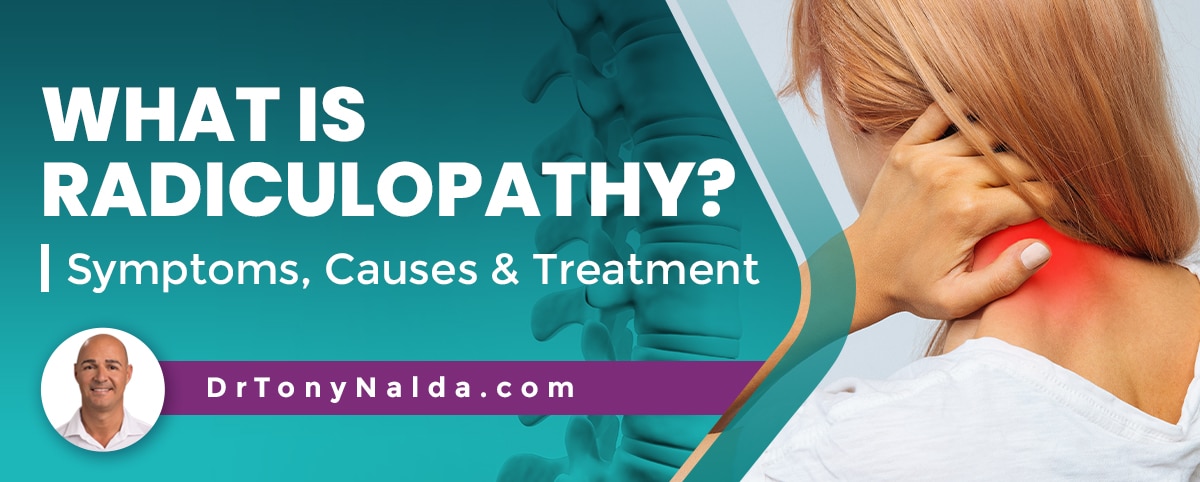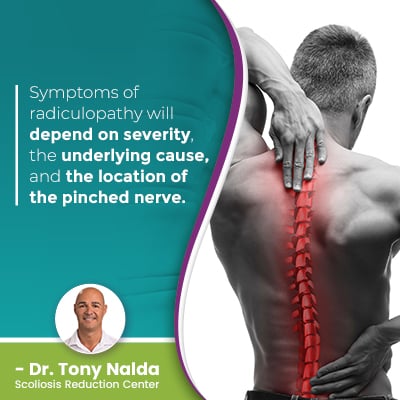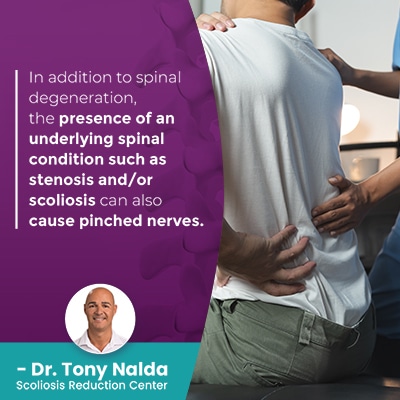What Is Radiculopathy? Symptoms, Causes & Treatment

There are 31 pairs of spinal nerves that make up the spinal cord, and if there is a loss of space within the spinal canal, through which the spinal cord passes, the nerves within can become pinched and irritated. Depending on the severity and location of the pinched nerve, different symptoms of radiculopathy can develop.
Radiculopathy is a nerve condition involving nerve pain and/or dysfunction felt anywhere along an affected nerve's pathway. When a nerve root is pinched, it's being exposed to uneven pressure, and there are different types of radiculopathy based on the location of the pinched nerve.
The spine is a complex structure with many moving parts and its health affects the body in different ways.
Table of Contents
Spinal Anatomy
The spine's natural and healthy curves keep it stronger, more flexible, and better able to absorb and distribute mechanical stress, and when its curves are in place, its vertebrae (bones of the spine) are aligned as they should be.
The vertebrae have a hollow opening at their centers so form a tunnel through which the spinal cord passes, and an intervertebral disc sits between adjacent vertebrae.
The health of the spinal discs are key to overall spinal health, strength, and function; they provide the spine with structure (adjacent vertebrae attach to the disc in between), cushioning to prevent friction during movement, combine forces to facilitate flexible movement, and act as the spine's shock absorbers.
In many cases of spinal conditions and issues, degenerative disc disease is a contributing factor because when a disc deteriorates, it changes shape, and this can cause an affected disc to take up more space within the spine, and that space is taken away from the spinal nerves, and without optimal space within which to function, nerves can become pinched, irritated, inflamed, and/or damaged.
Damaged discs can become bulging discs and/or herniated discs and cause other symtoms.
There are three main spinal sections, and radiculopathy can affect any: the cervical spine (the neck), the thoracic spine (middle/upper back), and the lumbar spine (lower back).
Different types of radiculopathy are determined by their location within the spine, and the area of the body located closest to the affected nerve root is the most likely to feel its direct effects.
Symptoms of Radiculopathy
 Symptoms of radiculopathy will depend on severity, the underlying cause, and the location of the pinched nerve.
Symptoms of radiculopathy will depend on severity, the underlying cause, and the location of the pinched nerve.
Nerves are like branches of a tree, fanning off in multiple directions, which is why nerve pain can be felt far from the affected nerve's location and be difficult to diagnose.
If a nerve is pinched in the cervical spine, it's going to cause symptoms felt in the upper spine and body such as muscle weakness and pain, neck pain, and tension headaches.
The cervical spine acts as the bridge between the brain and the rest of the body and has to support the weight of the neck, the head, and enable the head's ability to turn from side to side and look up and down.
If radiculopathy develops in the thoracic spine, the middle/upper spine and body are going to be affected, and as the thoracic spine is the largest spinal section, it's particularly vulnerable to the development of a number of spinal conditions/issues.
If lumbar radiculopathy is the type, a common complication is sciatica nerve pain because the sciatic nerve starts in the lumbar spine and extends down the back of the hip, buttock, leg, and into the foot.
The sciatic nerve is the largest nerve in the body so sciatic nerve pain can develop for a number of reasons including spinal degeneration and the presence of underlying spinal conditions such as stenosis and/or scoliosis.
Sciatic nerve pain can include sensations of tingling and/or numbness, and when severe and/or if left untreated can lead to digestive issues as the lower body is more affected over time, and once a nerve is damaged, it can be difficult, if not impossible, to reverse the damage.
The goal of treatment for radiculopathy is to relieve pressure on the affected nerve and prevent further damage.
Radiculopathy Causes
As mentioned, there are many different causes for a pinched spinal nerve root, and the most common is spinal degeneration, which most often involves the intervertebral discs.
While there is a certain amount of spinal degeneration to be expected with age, the cumulative effect of certain lifestyle factors also play a role in the level and rate of spinal degeneration: carrying excess weight, leading a sedentary lifestyle, chronic poor posture, repeatedly lifting heavy objects incorrectly, and excessive consumption of alcohol and/or smoking.
When the spine is degenerating, it's most often the discs that are affected; as discs degenerate, they change shape, taking room from nearby nerves, and this loss of space can cause nerves to become pinched.
In addition to spinal degeneration, the presence of an underlying spinal condition such as stenosis and/or scoliosis can also cause pinched nerves.
 Spinal stenosis is a spinal condition that involves the narrowing of the spinal canal, and this means a loss of space for the spinal nerves to function within, and when this happens, they can become irritated and/or inflamed, and the longer they are left in that condition, the more likely permanent damage is.
Spinal stenosis is a spinal condition that involves the narrowing of the spinal canal, and this means a loss of space for the spinal nerves to function within, and when this happens, they can become irritated and/or inflamed, and the longer they are left in that condition, the more likely permanent damage is.
Scoliosis involves the development of an unnatural sideways-bending and rotating spinal curve, and when the spine curves unnaturally, its nerves within are exposed to uneven pressure (compression), and this causes radiculopathy in the affected spinal section.
Radiculopathy can develop in any of the spine's main sections, but lumbar radiculopathy is the most common type because of the unique roles of the lumbar spine: supporting the weight of the spinal sections above, the entire trunk, and its vertebrae feel the effects of bending, lifting, and twisting movements.
For the aforementioned reasons, it's said that everyone will experience a degree of lower back pain at some point in their lives, and nerve-related back pain is generally thought to be the most debilitating form.
Radiculopathy Treatment
Radiculopathy treatment will depend on the condition's underlying cause.
If spinal degeneration is the cause of a nerve being pinched, preserving spinal function and preventing further damage is key, and this can be worked towards through a combination of chiropractic care and physical therapy.
When pressure is taken off an affected nerve, it can function as it was designed, and related symptoms such as pain, tingling, and numbness are alleviated as their underlying cause is addressed.
If a spinal condition like stenosis has caused a loss of space within the spinal canal causing one or more nerves to become pinched, chiropractic care can help create space within the spine by manually adjusting the position of affected vertebrae, taking pressure off impinged nerves.
With conditions like scoliosis that involve the development of an unnatural spinal curve that's pinching nerves within, an integrative treatment approach that combines chiropractic care, physical therapy, corrective bracing, and rehabilitation can impact conditions on every level, including its effect on the nervous system.
Conclusion
Radiculopathy is more commonly known as a pinched nerve, and this means a nerve that's exposed to uneven pressure anywhere along its pathway from its root where it exits the spine and extends to different areas of the body.
When a nerve is pinched, it becomes impinged and irritated, and this can affect its function and cause a variety of symptoms.
The more severely a nerve is impinged, the more overt its effects are likely to be, and the area of the body located closest to the pinched nerve is going to feel the majority of its direct effects.
In order to treat radiculopathy, its underlying cause has to be determined and a treatment plan customized around it.
If a condition like stenosis or scoliosis has caused the radiculopathy to develop, the underlying spinal condition has to be the focus of treatment, and this often involves a combination of physical therapy, chiropractic care, corrective bracing, and rehabilitation.
Here at the Scoliosis Reduction Center, the best way to minimize the effects of a variety of spinal conditions, radiculopathy included, is to address their underlying cause, and being proactive with treatment means starting as close to the time of diagnosis as possible.
The best way to improve nerve function is to take pressure off the affected nerve and its surroundings, and this can often be worked towards through a series of chiropractic techniques and manual adjustments.
In addition, when the spine's surrounding muscles are strengthened, they can optimally support and stabilize the spine, taking pressure off the spine itself.
In order to diagnose radiculopathy, a combined physical examination, documenting experienced symptoms, and X-ray results can confirm what's really happening in and around the spine.
Dr. Tony Nalda
DOCTOR OF CHIROPRACTIC
After receiving an undergraduate degree in psychology and his Doctorate of Chiropractic from Life University, Dr. Nalda settled in Celebration, Florida and proceeded to build one of Central Florida’s most successful chiropractic clinics.
His experience with patients suffering from scoliosis, and the confusion and frustration they faced, led him to seek a specialty in scoliosis care. In 2006 he completed his Intensive Care Certification from CLEAR Institute, a leading scoliosis educational and certification center.
About Dr. Tony Nalda
 Ready to explore scoliosis treatment? Contact Us Now
Ready to explore scoliosis treatment? Contact Us Now





